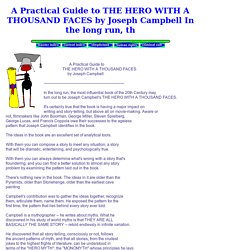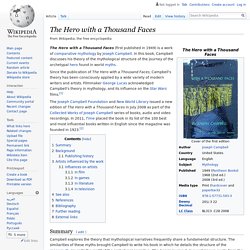

A Practical Guide to THE HERO WITH A THOUSAND FACES by Joseph Ca. A Practical Guide to THE HERO WITH A THOUSAND FACES by Joseph Campbell ----------------------------------------------------------------- In the long run, the most influential book of the 20th Century may turn out to be Joseph Campbell's THE HERO WITH A THOUSAND FACES.

It's certainly true that the book is having a major impact on writing and story-telling, but above all on movie-making. Aware or not, filmmakers like John Boorman, George Miller, Steven Spielberg, George Lucas, and Francis Coppola owe their successes to the ageless pattern that Joseph Campbell identifies in the book. The ideas in the book are an excellent set of analytical tools. With them you can compose a story to meet any situation, a story that will be dramatic, entertaining, and psychologically true. With them you can always determine what's wrong with a story that's floundering, and you can find a better solution to almost any story problem by examining the pattern laid out in the book.
The Hero with a Thousand Faces - Wikipedia, the free encyclopedi. The Hero with a Thousand Faces (first published in 1949) is a work of comparative mythology by Joseph Campbell.

In this book, Campbell discusses his theory of the mythological structure of the journey of the archetypal hero found in world myths. Since the publication of The Hero with a Thousand Faces, Campbell's theory has been consciously applied by a wide variety of modern writers and artists. Filmmaker George Lucas acknowledged Campbell's theory in mythology, and its influence on the Star Wars films.[1] Summary[edit] Campbell explores the theory that mythological narratives frequently share a fundamental structure.
A hero ventures forth from the world of common day into a region of supernatural wonder: fabulous forces are there encountered and a decisive victory is won: the hero comes back from this mysterious adventure with the power to bestow boons on his fellow man.[3] In laying out the monomyth, Campbell describes a number of stages or steps along this journey. Background[edit] Monomyth. Joseph Campbell's monomyth, or the hero's journey, is a basic pattern that its proponents argue is found in many narratives from around the world.

This widely distributed pattern was described by Campbell in The Hero with a Thousand Faces (1949).[1] Campbell, an enthusiast of novelist James Joyce, borrowed the term monomyth from Joyce's Finnegans Wake.[2] Campbell held that numerous myths from disparate times and regions share fundamental structures and stages, which he summarized in The Hero with a Thousand Faces: A hero ventures forth from the world of common day into a region of supernatural wonder: fabulous forces are there encountered and a decisive victory is won: the hero comes back from this mysterious adventure with the power to bestow boons on his fellow man.[3] A chart outlining the Hero's Journey.
Summary[edit] In a monomyth, the hero begins in the ordinary world, and receives a call to enter an unknown world of strange powers and events. The 17 Stages of the Monomyth[edit]